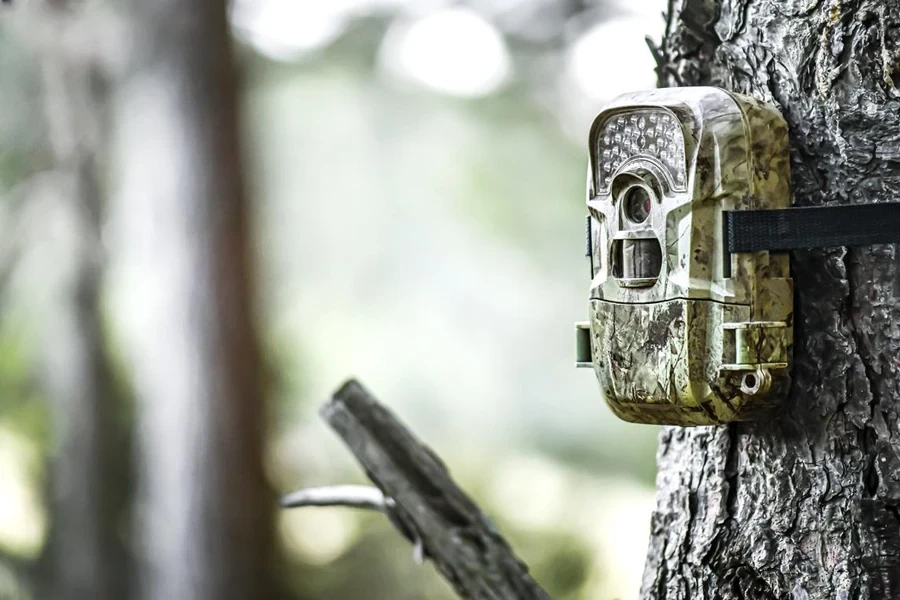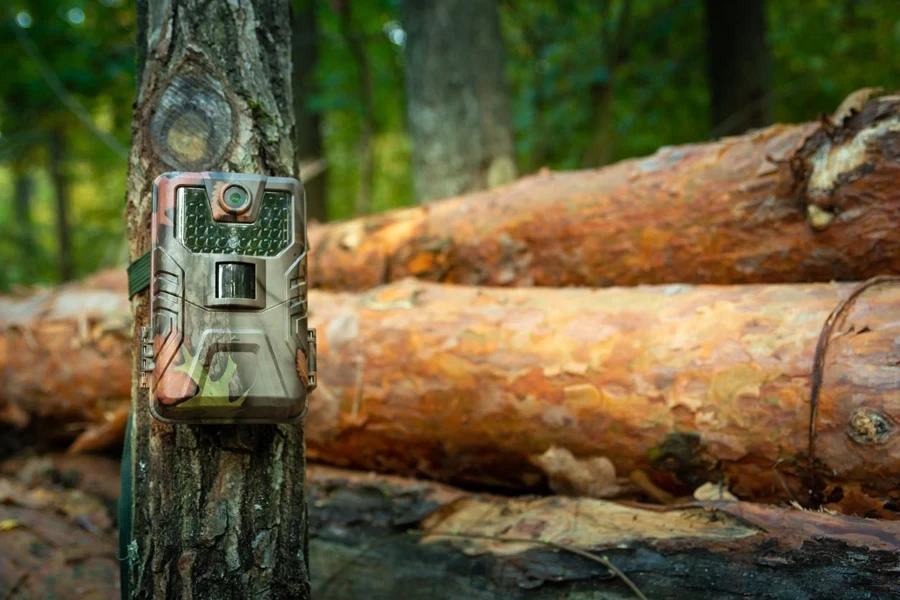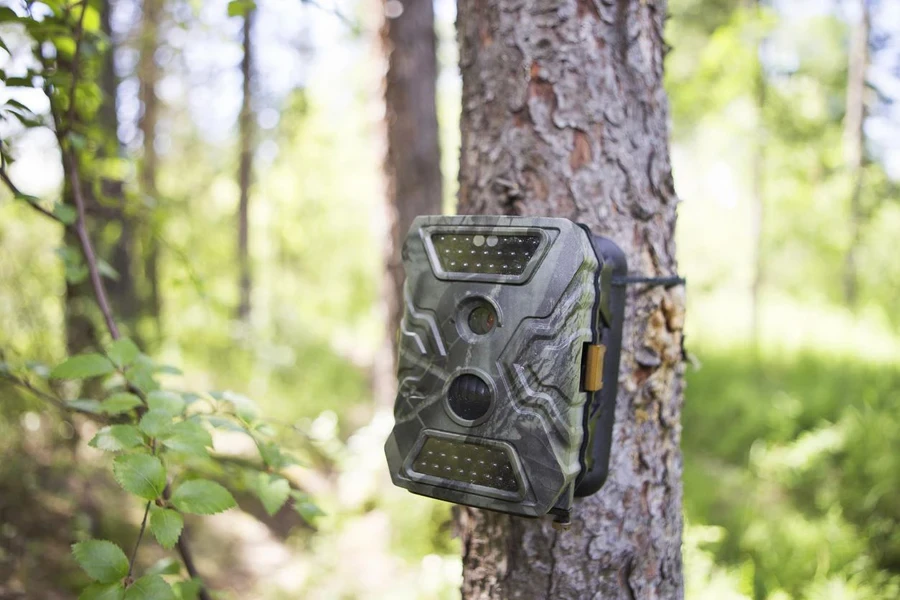Selecting the right hunting camera is crucial for effective wildlife monitoring and hunting activities in 2024. These advanced devices capture high-resolution images and videos, even in challenging conditions, helping users track game and observe wildlife with precision. With features like motion activation, night vision, and remote connectivity, modern hunting cameras offer unparalleled convenience and efficiency. They enable the collection of vital data over extended periods, ensuring thorough monitoring without frequent human intervention. For those involved in wildlife management or hunting, investing in the latest hunting camera technology can significantly enhance observation accuracy and operational effectiveness.
Table of Contents
1. Types and uses of hunting cameras
2. Current market landscape
3. Key considerations for selecting hunting cameras
4. Leading hunting camera models and their features
5. Conclusion
Types and uses of hunting cameras

Motion-activated trail cameras
Motion-activated trail cameras are a staple in wildlife monitoring and hunting. These cameras detect movement through sensors and automatically capture images or videos. The core technology involves passive infrared (PIR) sensors that detect changes in temperature and movement, triggering the camera to take a picture or start recording. These cameras are particularly useful for tracking wildlife activity in a specific area, as they only capture footage when there is movement, conserving battery life and storage space. Key features often include high-resolution imaging, night vision capabilities, and fast trigger speeds to ensure clear and timely captures of fast-moving animals.
One of the top models in this category is the Bushnell Core DS-4K No Glow, which offers 4K video resolution and 32MP stills. This model is designed to work both day and night, with dual sensors that optimize image quality for different lighting conditions. It also features no-glow infrared LEDs, which are invisible to animals, making it ideal for capturing nocturnal wildlife without disturbing them. Another notable mention is the Browning StrikeForce ProX1080, known for its 0.2-second trigger speed and 90 feet detection range, making it highly effective for capturing swift wildlife movements.
Cellular trail cameras
Cellular trail cameras represent a significant advancement in remote wildlife monitoring. These cameras utilize cellular networks to transmit captured images and videos directly to the user’s mobile device or email. This feature eliminates the need for physical retrieval of memory cards, reducing human presence and disturbance in wildlife areas. Cellular trail cameras are particularly beneficial for monitoring remote or inaccessible locations, providing real-time updates on wildlife activity.
The Spypoint Link-Micro-S-LTE is a leading model in this category, featuring a compact design and efficient solar panel for extended battery life. It offers 10MP image resolution and can transmit photos directly to the Spypoint app, allowing for instant access and remote management. Another example is the Bushnell Cellucore Live Cellular Trail Camera, which supports live streaming and dual-SIM card technology, ensuring the best available network connection. These cameras are essential tools for researchers and hunters who require continuous and immediate data without frequent site visits.
WiFi and Bluetooth trail cameras
WiFi and Bluetooth trail cameras provide a convenient way to access and manage captured footage without physically handling the camera. These cameras connect to nearby devices via WiFi or Bluetooth, allowing users to download images and videos directly to their smartphones or tablets. This connectivity is particularly useful for quickly reviewing footage in the field and adjusting camera settings on the go.
The Toguard 4K 48MP WiFi Trail Camera is an excellent example, offering high-resolution 4K video and 48MP stills. It features a fast trigger speed of 0.3 seconds and allows users to view images over WiFi without pulling out the memory cards. Another model, the GardePro E6 WiFi Trail Camera, boasts 24MP image resolution and a reliable Bluetooth/WiFi connection, enabling users to manage their cameras from a distance of up to 50 feet. These cameras are ideal for tech-savvy users who prefer seamless and immediate access to their data.
Solar-powered trail cameras
Solar-powered trail cameras are designed for eco-conscious users looking to minimize their environmental impact while ensuring long-term operation. These cameras come with integrated solar panels that recharge their internal batteries, significantly extending their operational life and reducing the need for frequent battery changes. This feature is particularly advantageous for cameras placed in remote locations where regular maintenance is challenging.
The Sehmua 4G LTE 3rd Gen Cellular Trail Camera stands out with its robust solar charging capabilities, offering HD 1080p video and a quick 0.07-second trigger speed. Its cellular connectivity allows for remote monitoring and data transmission, making it a versatile option for extended wildlife observation. Solar-powered cameras like these are not only environmentally friendly but also highly practical for sustained use in the field.
In summary, hunting cameras come in various types, each with specific features tailored to different monitoring needs. Motion-activated trail cameras excel in capturing wildlife activity efficiently, while cellular trail cameras provide the convenience of remote data access. WiFi and Bluetooth models offer quick and easy connectivity, and solar-powered cameras ensure long-term operation with minimal maintenance. Selecting the right type of hunting camera depends on the specific requirements of the monitoring task and the operational environment.
Current market landscape

Market growth and trends
The hunting camera market has witnessed significant growth over recent years, driven by advancements in technology and increasing demand for wildlife monitoring tools. According to recent market reports, the global trail camera market is projected to continue its upward trajectory, with an expected compound annual growth rate (CAGR) of around 7.5% from 2023 to 2028. This growth is fueled by the increasing adoption of trail cameras for both recreational and research purposes. Technological innovations such as higher resolution imaging, faster trigger speeds, and enhanced connectivity options are key factors contributing to this market expansion.
Emerging trends in the hunting camera market include the integration of artificial intelligence (AI) and machine learning (ML) capabilities, which enable more precise animal detection and behavior analysis. Additionally, the development of multi-functional trail cameras that offer features like real-time streaming and advanced data analytics is gaining traction. The push towards eco-friendly solutions has also led to the rise in popularity of solar-powered trail cameras, which offer sustainable and cost-effective options for long-term wildlife monitoring.
Experts currently value the hunting camera market at approximately US$ 120 million, and they expect it to reach US$ 180 million by 2028. They estimate this boost will happen at a 7.5% compound annual growth rate (CAGR) from 2023 to 2028.
Key market players
The hunting camera market is dominated by several key manufacturers known for their innovative products and substantial market share. Leading brands such as Bushnell, Browning, and Spypoint are at the forefront, offering a wide range of high-performance trail cameras tailored to various user needs. Bushnell, for instance, is renowned for its robust and technologically advanced models like the Bushnell Core DS-4K No Glow, which is favored for its exceptional video quality and durability.
Browning has carved a niche with models like the StrikeForce ProX1080, known for its quick trigger speed and reliable performance. Spypoint, on the other hand, is a leader in cellular trail cameras, with models like the Spypoint Link-Micro-S-LTE gaining popularity for their remote monitoring capabilities. Other notable players include Stealth Cam, which offers a range of beginner-friendly and advanced models, and GardePro, known for its cost-effective yet high-quality trail cameras.
Consumer preferences
Consumer preferences in the hunting camera market are heavily influenced by the specific features and capabilities that these devices offer. High-resolution imaging and video quality are top priorities for buyers, as these features ensure clear and detailed footage of wildlife. Cameras like the Toguard 4K 48MP WiFi Trail Camera and the GardePro A3S Trail Camera are particularly popular for their superior image quality and advanced functionalities.
Ease of use and connectivity options also play a significant role in consumer choices. Many users prefer cameras with WiFi, Bluetooth, or cellular capabilities that allow for remote access and management of the devices. Models such as the GardePro E6 WiFi Trail Camera and the Bushnell Cellucore Live Cellular Trail Camera cater to this demand by offering seamless connectivity and user-friendly interfaces.
Durability and battery life are other critical factors that consumers consider when purchasing hunting cameras. Trail cameras that can withstand harsh environmental conditions and operate efficiently over long periods without frequent battery changes are highly sought after. Solar-powered models like the Sehmua 4G LTE 3rd Gen Cellular Trail Camera address these needs by providing sustainable and long-lasting power solutions.
In conclusion, the hunting camera market is experiencing robust growth driven by technological advancements and evolving consumer preferences. Key players continue to innovate, offering a diverse range of products that meet the demands for high-quality imaging, advanced connectivity, and durability. Understanding these market dynamics and consumer preferences is essential for making informed purchasing decisions in this rapidly evolving industry.
Key considerations for selecting hunting cameras

Resolution and image quality
Resolution and image quality are fundamental when selecting a hunting camera. High-resolution images and videos ensure that fine details are captured, making it easier to identify animals and monitor their behavior. Cameras with resolutions of 20MP or higher are ideal for detailed observations. For instance, the Bushnell Core DS-4K No Glow offers 32MP stills and 4K video recording, providing exceptionally clear and detailed footage. High-resolution cameras are particularly beneficial in low-light conditions, where image clarity can significantly impact the quality of data collected.
Advanced sensors and image processors also play a crucial role in enhancing image quality. Cameras equipped with Sony Exmor R CMOS sensors, like the GardePro A3S Trail Camera, deliver superior low-light performance, capturing clear images during dawn and dusk. Additionally, the inclusion of wide dynamic range (WDR) technology helps balance light and shadow, ensuring optimal image quality in varying lighting conditions.
Trigger speed and detection range
Trigger speed and detection range are critical features that influence the effectiveness of hunting cameras in capturing wildlife activity. Trigger speed refers to the time it takes for the camera to activate and capture an image after detecting motion. A fast trigger speed, typically around 0.2 seconds or less, ensures that even the quickest animals are captured without blurring. The Browning StrikeForce ProX1080, for example, has a trigger speed of 0.2 seconds, making it highly efficient in capturing swift movements.
Detection range determines the distance over which the camera can detect motion. Cameras with a longer detection range can cover larger areas, increasing the likelihood of capturing wildlife activity. The Bushnell Cellucore Live Cellular Trail Camera boasts a detection range of up to 100 feet, making it suitable for extensive monitoring areas. Additionally, some cameras feature adjustable sensitivity settings, allowing users to customize the detection range based on the specific environment.
Battery life and power options
Battery life is a significant consideration, especially for cameras placed in remote locations where frequent maintenance is impractical. Long battery life ensures continuous operation, reducing the need for regular battery replacements. Many modern hunting cameras, like the Spypoint Link-Micro-S-LTE, are designed with energy-efficient components and can operate for several months on a single set of batteries.
Solar-powered trail cameras offer an eco-friendly and sustainable power solution. The Sehmua 4G LTE 3rd Gen Cellular Trail Camera integrates a solar panel that recharges the internal battery, providing virtually unlimited power in sunny conditions. This feature is particularly advantageous for long-term wildlife monitoring projects, as it eliminates the need for regular battery replacements and ensures uninterrupted operation.
Durability and weather resistance
Durability and weather resistance are essential for hunting cameras, as they are exposed to harsh outdoor conditions. A robust build and weatherproof design protect the camera from rain, snow, dust, and extreme temperatures. Cameras like the Browning StrikeForce HD Pro X are built with rugged materials and feature waterproof seals, ensuring reliable performance in all weather conditions.
Advanced models also include features such as dustproof housings and impact-resistant casings, which further enhance their durability. These features are crucial for cameras deployed in challenging environments, ensuring they can withstand physical impacts and environmental stress without compromising functionality.
Additional features
Modern hunting cameras come equipped with various additional features that enhance their functionality and usability. Night vision capabilities are essential for capturing nocturnal wildlife activity. Cameras like the Reconyx Hyperfire 2 use infrared LEDs to provide clear night-time images without startling animals. This feature is crucial for comprehensive 24/7 wildlife monitoring.
Time-lapse mode is another valuable feature, allowing users to capture a series of images over a set period. This mode is useful for observing patterns in wildlife behavior and movement. GPS tagging is also beneficial, especially for large-scale wildlife research projects, as it helps track the camera’s location and organize data efficiently. The Spypoint Link-Micro-S-LTE includes GPS tagging, providing an added layer of functionality.
By considering these key factors—resolution, trigger speed, battery life, durability, and additional features—business professionals can select the most suitable hunting cameras for their needs. These considerations ensure that the chosen equipment will provide accurate, reliable, and high-quality data for effective wildlife monitoring and research.
Leading hunting camera models and their features

Bushnell Core DS-4K No Glow
The Bushnell Core DS-4K No Glow is a top-rated hunting camera known for its superior features and high performance. This model is equipped with dual sensors to optimize image quality during both day and night, ensuring clear and detailed visuals regardless of lighting conditions. The camera captures 4K video and 32MP still images, providing exceptionally sharp and high-resolution footage. Its no-glow infrared lighting makes it ideal for capturing nocturnal wildlife without disturbing them. With a trigger speed of 0.2 seconds and a detection range of up to 100 feet, the Bushnell Core DS-4K No Glow is perfect for comprehensive wildlife monitoring in large areas.
One of the standout features of this camera is its rugged and weatherproof design, which ensures durability in harsh outdoor environments. The camera is built to withstand extreme temperatures and weather conditions, making it a reliable choice for long-term field use. Additionally, it offers a variety of customizable settings, allowing users to fine-tune the camera to their specific needs. Whether for research, wildlife observation, or hunting, the Bushnell Core DS-4K No Glow provides unmatched performance and reliability.
Browning StrikeForce ProX1080
The Browning StrikeForce ProX1080 is highly recommended for its excellent performance and value. This model features a super-fast trigger speed of 0.2 seconds and a detection range of 90 feet, ensuring that it captures even the quickest movements without missing any action. The camera records 1080p HD video with sound, and its 20MP still images offer clear and detailed pictures. One of the unique aspects of the StrikeForce ProX1080 is its innovative metal mounting bracket, which allows for easy and secure installation at various angles.
Designed for ease of use, the Browning StrikeForce ProX1080 has a user-friendly interface and is straightforward to set up. Its compact size and durable construction make it suitable for various environments, from dense forests to open fields. The camera operates on six AA batteries, providing long battery life and ensuring continuous operation over extended periods. This model is ideal for those looking for a high-performance camera at a mid-range price point, combining speed, quality, and reliability.
Spypoint Link-Micro-S-LTE
The Spypoint Link-Micro-S-LTE is a standout cellular trail camera known for its compact design and advanced connectivity features. This model allows users to receive images directly on their mobile devices via the Spypoint app, eliminating the need for manual retrieval of SD cards. It captures 10MP still images and has a detection range of 80 feet, with a trigger speed of 0.5 seconds. The camera’s integrated solar panel significantly extends battery life, making it a sustainable and cost-effective option for long-term use.
Ideal for remote monitoring, the Spypoint Link-Micro-S-LTE provides real-time updates and alerts, ensuring that users are always informed about wildlife activity in the monitored area. The camera is also equipped with advanced motion detection technology, reducing false triggers and ensuring that only relevant activity is captured. Its rugged and weatherproof design ensures durability and reliable performance in various environmental conditions, making it a top choice for both researchers and hunters.
Stealth Cam DS4K Ultimate
The Stealth Cam DS4K Ultimate is designed for users who need a combination of advanced features and ease of use. This model captures 32MP still images and records 4K video, providing high-quality footage with excellent detail. It features a trigger speed of 0.2 seconds and a detection range of 100 feet, ensuring quick and comprehensive coverage of the monitored area. The camera’s no-glow infrared emitters make it ideal for nighttime surveillance, capturing clear images without alerting wildlife.
One of the key features of the Stealth Cam DS4K Ultimate is its user-friendly interface, which includes Quick Set pre-programmed modes for easy setup. This makes it an excellent choice for beginners or those looking for a hassle-free experience. The camera also offers multiple custom settings, allowing users to tailor its operation to specific needs. Its durable construction and weather-resistant design ensure reliable performance in harsh outdoor conditions, making it a versatile and dependable option for various applications.
GardePro A3S trail camera
The GardePro A3S trail camera is a budget-friendly option that does not compromise on quality. This model captures 24MP still images and records 1296p HD video, providing clear and detailed visuals. It features a trigger speed of 0.1 seconds and a detection range of 82 feet, making it highly effective for capturing fast-moving wildlife. The camera’s advanced night vision capabilities, using no-glow infrared LEDs, ensure that it can capture clear images even in complete darkness.
Designed for easy use and setup, the GardePro A3S includes a 2.4-inch color screen for quick review of captured footage. Its robust construction and weatherproof design make it suitable for various outdoor environments. The camera operates on eight AA batteries, providing long-lasting power for extended monitoring periods. The GardePro A3S is ideal for those seeking a high-performance trail camera at an affordable price, offering a perfect balance of quality, speed, and reliability.
By understanding the features and benefits of these leading hunting camera models, business professionals can make informed decisions and select the best equipment to meet their specific monitoring and research needs. Each model offers unique advantages, ensuring there is an option suitable for every application and budget.
Comparative analysis of best models
Image Quality and Resolution
Image quality and resolution are paramount when selecting a hunting camera. The Bushnell Core DS-4K No Glow stands out with its 32MP still images and 4K video resolution, providing unparalleled clarity and detail. This is especially useful for researchers who need high-definition images for detailed analysis. In comparison, the Browning StrikeForce ProX1080 offers 20MP still images and 1080p HD video, which, while slightly lower in resolution, still provides excellent image quality suitable for most monitoring needs.
The Spypoint Link-Micro-S-LTE, with its 10MP image resolution, offers good quality but is more suited for general monitoring rather than detailed wildlife study. The Stealth Cam DS4K Ultimate also captures 32MP stills and 4K video, putting it on par with the Bushnell in terms of resolution. For budget-conscious users, the GardePro A3S provides 24MP still images and 1296p HD video, offering a good balance between quality and cost.
Trigger Speed and Detection Range
Trigger speed and detection range are critical for capturing fast-moving animals. The Browning StrikeForce ProX1080 boasts a trigger speed of 0.2 seconds and a detection range of 90 feet, ensuring quick and comprehensive coverage. The Bushnell Core DS-4K No Glow matches this trigger speed but extends its detection range to 100 feet, making it ideal for monitoring larger areas.
The Spypoint Link-Micro-S-LTE, with a 0.5-second trigger speed and an 80-foot detection range, offers slightly slower performance but compensates with its cellular connectivity. The Stealth Cam DS4K Ultimate, with a 0.2-second trigger speed and 100-foot detection range, is comparable to the Bushnell, making it suitable for high-speed wildlife tracking. The GardePro A3S, with a 0.1-second trigger speed and 82-foot detection range, excels in capturing quick movements, making it a competitive option despite its lower price point.
Power Options and Battery Life
Long battery life and reliable power options are essential for reducing maintenance in remote locations. The Bushnell Core DS-4K No Glow operates on six AA batteries, providing extended usage. Its energy-efficient design ensures long-lasting performance, even in harsh conditions. Similarly, the Browning StrikeForce ProX1080 uses six AA batteries and is known for its efficient power consumption, making it suitable for long-term deployment.
The Spypoint Link-Micro-S-LTE features an integrated solar panel, significantly extending its battery life and reducing the need for frequent replacements. This makes it a sustainable option for remote monitoring. The Stealth Cam DS4K Ultimate uses 12 AA batteries, providing ample power for its high-resolution capabilities. The GardePro A3S, powered by eight AA batteries, offers a good balance between battery life and performance, ensuring reliable operation over extended periods.
Durability and Weather Resistance
Durability and weather resistance are crucial for ensuring reliable performance in outdoor environments. The Bushnell Core DS-4K No Glow is built with a rugged, weatherproof design, capable of withstanding extreme temperatures and adverse weather conditions. This makes it an excellent choice for year-round monitoring in various environments.
The Browning StrikeForce ProX1080 also features a robust construction with a weatherproof casing, ensuring durability and reliable performance in harsh conditions. The Spypoint Link-Micro-S-LTE, with its compact and weather-resistant design, is ideal for discreet placement in challenging environments. The Stealth Cam DS4K Ultimate, with its durable construction and weatherproof features, is designed to endure extreme conditions, making it suitable for demanding fieldwork. The GardePro A3S, with its solid build and weatherproof design, offers reliable performance at a budget-friendly price, ensuring durability in various outdoor settings.
Additional Features
Modern hunting cameras come with various additional features that enhance their functionality. The Bushnell Core DS-4K No Glow includes no-glow infrared LEDs, making it ideal for capturing nocturnal wildlife without disturbing them. It also features advanced motion detection and customizable settings for tailored monitoring.
The Browning StrikeForce ProX1080 offers a unique metal mounting bracket for easy installation and adjustment, along with high-quality night vision capabilities. The Spypoint Link-Micro-S-LTE stands out with its cellular connectivity, allowing real-time updates and remote access via the Spypoint app. This feature is particularly beneficial for users who require immediate access to data without visiting the camera site.
The Stealth Cam DS4K Ultimate includes Quick Set pre-programmed modes for easy setup and a variety of custom settings for detailed monitoring. Its burst mode can capture up to nine images per trigger, providing comprehensive coverage of wildlife activity. The GardePro A3S, with its advanced night vision and user-friendly interface, offers excellent value with features typically found in higher-end models, such as time-lapse mode and GPS tagging.
By comparing these leading models based on their features and performance, business professionals can make informed decisions to select the most suitable hunting cameras for their specific needs. Each model offers unique advantages, ensuring there is an option that meets various monitoring and research requirements.
Conclusion
Selecting the right hunting camera is crucial for achieving optimal results in wildlife monitoring and hunting activities. By considering key factors such as image quality, trigger speed, detection range, battery life, durability, and additional features, businesses can choose models that meet their specific needs. Top models like the Bushnell Core DS-4K No Glow, Browning StrikeForce ProX1080, Spypoint Link-Micro-S-LTE, Stealth Cam DS4K Ultimate, and GardePro A3S offer unique advantages and capabilities. Understanding these features ensures that the selected hunting camera will provide accurate, reliable, and high-quality data, enhancing the effectiveness of wildlife observation and research initiatives.



